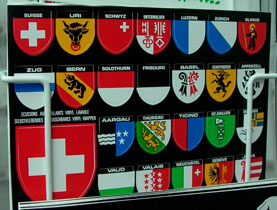Cantons

The majority of Switzerland's 26 cantons trace their roots back hundreds of years. Their fundamental autonomy has always been respected, and remains strong to this day.
After the brief civil war of 1847, the main challenge for modern Switzerland’s founders in 1848 was to forge a federal framework that involved a higher measure of centralization, while still accommodating the country’s diverse political, linguistic and ethnic elements.
The devolution of power, already a reality, continued. This tradition has survived to present times.
A number of policy matters, such as education, police and most taxation issues, are decided at the cantonal level. In the absence of federal legislation, more than a dozen intercantonal conferences regulate these issues.
Territorial integrity
Switzerland is divided into 20 full cantons and six half cantons, a division set down in the federal constitution.
Although the internal autonomy of cantons is exactly the same for full and half cantons, half cantons have only one instead of two seats in the Senate, and a half vote in cases where a majority of cantons must approve constitutional changes in popular votes.
The cantons vary widely in size and significance. According to recent figures, Zurich has the most inhabitants, 1.3 million, and Appenzell Inner Rhodes the least, 15, 171. Switzerland has a population of around seven million.
The smallest canton is Basel City, with 37 square kilometers, and the largest is Graubünden, with 7105 square kilometers. Switzerland as a whole covers 41, 285 square kilometers (15,940 square miles), about the size of the US states of Massachusetts and Rhode Island together.
History
Switzerland’s roots go back to 1291, when, according to legend, local notables in central Switzerland pledged to form an alliance bringing together Uri, Schwyz and Unterwalden, the first three cantons.
This charter united the so-called forest cantons against Habsburg rule. With their defeat of a Habsburg army in 1315, Switzerland’s existence as its own entity inside the Holy Roman Empire took root.
The confederation was built up piecemeal, with additional cantons or states coming in to the alliance as largely autonomous entities. The original three cantons were joined by five more cantons and states – Zurich, Bern, Lucerne, Glarus and Zug – between 1353 and 1481.
Fribourg and Solothurn joined the “Old Confederacy” of eight cantons following approval of the Stanser Treaty in 1481, which balanced the interests of the cities and countryside.
By 1513, Basel, Schaffhausen and Appenzell had signed on. In 1648 Switzerland was formally released from the Holy Roman Empire.
Centralist episode
The “Helvetic Revolution” of 1798 crushed the aristocratic rule in the old cantons, brought the old confederation to an end and formed a unitary republic modeled on that of France, supported by Napoleon’s occupying troops.
After the fall of Napoleon and the signing of the Congress of Vienna in 1815, a period that also marked the formal recognition of Swiss neutrality, Switzerland reverted back to a cantonal association.
Nine more territories became part of Switzerland between 1803 and 1815: St Gallen, Graubünden, Aargau, Thurgau, Ticino, Vaud, Valais, Neuchâtel and Geneva.
This remained the composition of Switzerland until 1979. After a decades-long struggle, most of the French-speaking part of canton Bern broke away and was admitted into the confederation as Jura, the 26th canton.
With few exceptions, the cantonal boundaries have remained the same over decades.
Powers
The cantons’ political structures strongly resemble those of the Swiss federation founded in 1848.
Their constitutions, like all Swiss constitutions, are ratified by popular referendum. They change over time and are amended frequently.
The cantonal executive, like the Federal Council, is set up as a collegial government, with power vested in a committee, not an individual. Cantonal executives have five to seven members, and are elected by the people. Their parliaments have one chamber and are known by different names in different cantons.
Similar to the US, all powers not specifically reserved for the federal government belong to the cantons and communal governments.
Cantons and communal governments can raise taxes and make their own laws, as long as they are in line with federal legislation. They elect their own governments. Around a fifth of Switzerland’s more than 2,600 local authorities have their own parliaments.
All cantons and communes grant “direct democracy” rights to their citizens. These are referendums to force a popular vote on laws, and popular initiatives to demand a vote on a proposed change of the constitution.
In two cantons, Glarus and Appenzell Inner Rhodes, these rights of the citizenry are exercised by the “Landsgemeinde” – an open air assembly which is believed to date back more than 1,500 years.

In compliance with the JTI standards
More: SWI swissinfo.ch certified by the Journalism Trust Initiative









You can find an overview of ongoing debates with our journalists here . Please join us!
If you want to start a conversation about a topic raised in this article or want to report factual errors, email us at english@swissinfo.ch.